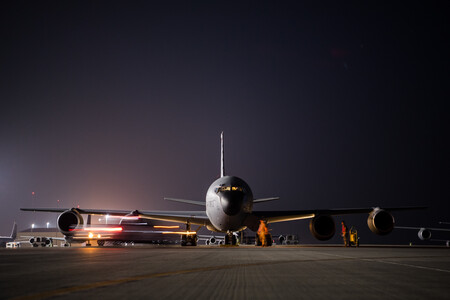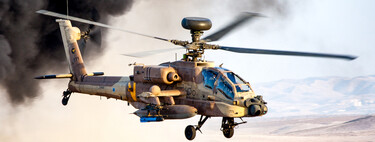While the spotlights point to B-2 bombers, there are other displayed planes that go through practically unnoticed: KC-135 Stratotankerveterans with more than six decades of service that have once again operated in the Middle East, just when the United States has attacked several nuclear facilities in Iranian territory, including Fordow, after reinforcing their military presence in the region in full climb with Israel. They do not launch missiles or participate in direct attacks, but their role is essential: they allow fighters, bombers and recognition planes to hold prolonged flights without landing.
In the military deployment that the United States is executing in the Middle East, the KC-135 Stratotanker is not a footnote. It is part of the logistics nucleus that allows aerial machinery to continue working without interruptions. According to media such as Reuters and BBC, at least 30 tank aircraft have been mobilized, mostly of this model, to accompany F-16, F-22, F-35 fighters and other air assets deployed in the region.

Its function may seem secondary to the naked eye, but has direct strategic implications: to the replenish in flightthe KC-135 eliminates the need for aircraft to interrupt their mission to refuel on land. That translates into operational continuity, greater tactical autonomy. And it’s not just a support for fighters. It also serves as a support for bombers, recognition aircraft, medical units and, when necessary, allied forces
A beast with more than 60 years of history (and still has rope)
When the KC-135 flew for the first time in 1956, the world was another. The cold war dominated the military strategy, and the United States needed a fleet capable of sustaining its aerial power at a global scale. Boeing offered a solution: a military variant of model 367-80, the prototype that would also give rise to the mythical 707. Thus the Stratotanker was born, which began to reach the air bases in 1957 and that, against all prognosis, remains in service in full 2025.
Of the more than 700 built copies, much was subjected to a process of radical modernization. The most visible change: engines. The ancients were replaced by CFM56, more efficient, powerful and silent turbo. Thanks to them, the KC-135R-the most common version today— consume 25% lessit costs 25% less operating and is almost 96% quieter than the original model, according to official US Air Force data.
But not everything has been mechanical. Throughout the decades, the KC-135 has also been adapted for very different tasks: aerial command, surveillance, experimental tests or even missions in compliance with the open skies treaty. Few platforms have demonstrated so much versatility and resistance to the passage of time.
How the Replacement in Flight works
From outside it may seem a simple maneuver: two planes flying nearby, one transfers fuel and everything continues as if nothing. But in reality, aerial refueling is an extremely delicate operation that requires Perfect coordination between pilots and operator. In KC-135, this task falls on the call boom operatora crew member that is located at the back of the plane, lying down, with direct vision of the receiver and total control over the extensible pole of refueling.


That articulated arm (flying boom) It is the main tool of KC-135 to transfer fuel in flight. Its design allows a precise connection between aircraft that fly at high speed and altitude. The connection requires absolute concentration: the operator guides contact and keeps it stable even in turbulence or maneuvering conditions.
In addition to the pole system, some KC-135 are equipped with an additional system: the druga kind of aerodynamic funnel that allows us to refuel aircraft with probes, as European helicopters or fighters. There are also models with pods in the wings that allow supplying two planes at the same time. All this makes Stratotanker a flexible platform, capable of adapting to multiple configurations according to the mission.
A key piece also in the modern war
Behind his austere silhouette and his gray paint without ornaments, the KC-135 hides an optimized machine for efficiency. It is propelled by four large thrust engines, capable of taking it at speeds close to 850 km/Hy to operate at altitudes up to 15,240 meters. He is not intended for agility or combat, but meets an immovable premise: being there when he is needed.


Can take off with a maximum weight of 146 tons and transport more than 90 tons of fuel to transfer to other aircraft. If the mission requires it, it can also load up to 37 passengers or about 38,000 kilos of material on the upper cover, just above the refueling system. All this in a structure of 41.5 meters long, with a wingspan close to 40 meters.
As for its reach, it can cover more than 2,400 km with 68 tons of transferable fuel on board. In type missions ferrywithout external load, can exceed 17,700 km, allowing intercontinental flights without scales.

In medical evacuation missions, the KC-135 becomes a kind of flying ICU. Thanks to special pallets, you can transport patients on a stretcher with a specific medical crew. It is this versatility is what Stratotanker has made a piece difficult to replace.
The KC-135 continues active duty more than SEis decades later of his first flight. Although the KC-46 Pegasus has already begun to assume part of its functions, Stratotanker remains one of the main reprisals of the US Air Force. Its maintenance, its successive modernizations and its capacity proven in multiple scenarios explain its constant presence in long -range operations.
Imágenes | U.S. Air Force (1, 2, 3, 4) | Master Sgt. Vincent De Groot | U.S. Department of Defense
In WorldOfSoftware | We prepare to say goodbye to Windows 10, but part of the US Air Control still works with disks and Windows 95










